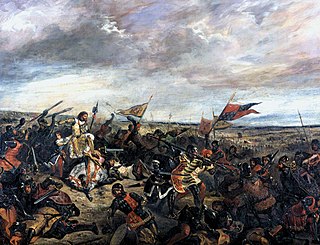
The Battle of Poitiers was fought on 19 September 1356 between a French army commanded by King John II and an Anglo-Gascon force under Edward, the Black Prince, during the Hundred Years' War. It took place in western France, 5 miles (8 km) south of Poitiers, when approximately 14,000–16,000 French attacked a strong defensive position held by 6,000 Anglo-Gascons.
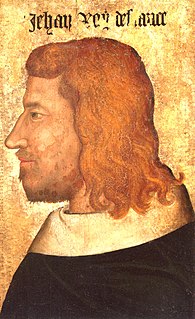
John II, called John the Good, was King of France from 1350 until his death in 1364. When he came to power, France faced several disasters: the Black Death, which killed nearly 40% of its population; popular revolts known as Jacqueries; free companies of routiers who plundered the country; and English aggression that resulted in catastrophic military losses, including the Battle of Poitiers of 1356, in which John was captured.
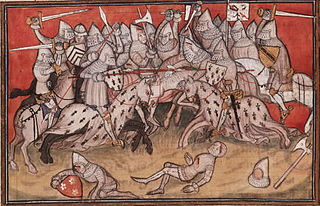
The War of the Breton Succession was a conflict between the Counts of Blois and the Montforts of Brittany for control of the Sovereign Duchy of Brittany, then a fief of the Kingdom of France. It was fought between 1341 and 12 April 1365. It is also known as the War of the Two Jeannes due to the involvement of two queens of that name.
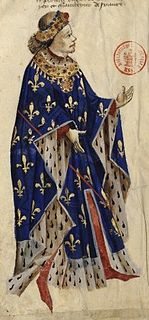
Louis I, called the Lame was a French prince du sang, Count of Clermont-en-Beauvaisis and La Marche and the first Duke of Bourbon, as well as briefly the titular King of Thessalonica from 1320 to 1321.

Peter I of Bourbon was the second Duke of Bourbon, from 1342 to his death. Peter was son of Louis I of Bourbon, whom he also succeeded as Grand Chamberlain of France, and Mary of Avesnes.

Étienne Marcel was provost of the merchants of Paris under King John II of France, called John the Good. He distinguished himself in the defence of the small craftsmen and guildsmen who made up most of the city population.
A chevauchée was a raiding method of medieval warfare for weakening the enemy, primarily by burning and pillaging enemy territory in order to reduce the productivity of a region, as opposed to siege warfare or wars of conquest. The use of the chevauchée declined at the end of the 14th century as the focus of warfare turned to sieges. It is conceptually similar to the scorched earth strategies used in modern warfare.

The first phase of the Hundred Years' War between France and England lasted from 1337 to 1360. It is sometimes referred to as the Edwardian War because it was initiated by King Edward III of England, who claimed the French throne in defiance of King Philip VI of France. The dynastic conflict was caused by disputes over the French feudal sovereignty over Aquitaine and the English claims over the French royal title. The Kingdom of England and its allies dominated this phase of the war.

Geoffroi de Charny was the third son of Jean de Charny, the lord of Charny, and Marguerite de Joinville, daughter of Jean de Joinville, the biographer and close friend of France’s King Louis IX. A renowned knight who fought on the French side during the early years of the Hundred Years’ War, Charny wrote a semi-autobiographical poem The Book of Geoffroi de Charny and a set of questions on chivalric matters for the short-lived Company of the Star, France’s counterpart to England’s Order of the Garter. Although a prose treatise called the Book of Chivalry has also long been accredited to him recent findings indicate this to have been more likely by his son of the same name, Geoffroi II de Charny, who died in 1398. Charny is also widely associated with the first known showings of the Shroud of Turin, though there are now doubts that he was responsible for these. He took part in a successful crusading expedition to Smyrna in 1344 and shortly after his return from this King Philip VI appointed him a royal councillor and bearer of the Oriflamme, the sacred battle-standard of France. This rôle, one in which he continued under King Jean II, made its holder an automatic target for enemy forces on a battlefield, and it was thus that he met his heroic end during the closing moments of the battle of Poitiers on September 19, 1356. Geoffroi de Charny was one of Europe's most admired knights during his lifetime, with a widespread reputation for his skill at arms and his honour. The Tournai-based abbot-chronicler Gilles le Muisit wrote of him: ‘a vigorous soldier, expert in weaponry and much renowned both overseas and here. He has taken part in many wars and in many mortal conflicts, in all of them conducting himself with probity and with nobility’.
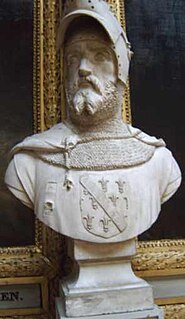
James I of Bourbon, was a French prince du sang, and the son of Louis I, Duke of Bourbon and Mary of Avesnes. He was Count of Ponthieu from 1351 to 1360, and Count of La Marche from 1341 to his death.
Events from the 1350s in England.

Robert I of Bar was Marquis of Pont-à-Mousson and Count and then Duke of Bar. He succeeded his elder brother Edward II of Bar as count in 1352. His parents were Henry IV of Bar and Yolande of Flanders.
The Second War of Scottish Independence broke out in 1332 when Edward Balliol led an English-backed invasion of Scotland. Balliol, the son of a former Scottish king, was attempting to make good his claim to the Scottish throne against that of Robert Bruce's eight-year-old son David II. Balliol's force defeated a Scottish army ten times their size and Balliol took the throne. Within three months the Bruce partisans had regrouped and forced Balliol out of Scotland. Balliol appealed to the English King, Edward III, who invaded Scotland in 1333 and besieged the important trading town of Berwick. A large Scottish army attempted to relieve it but was heavily defeated at the Battle of Halidon Hill. Balliol established his authority over most of Scotland, ceded to England the eight counties of south-east Scotland and did homage to Edward for the rest of the country as a fief.

Guy I of Clermont-Nesle was a Marshal of France, Seigneur (Lord) of Offemont jure uxoris, and possibly of Ailly, Maulette and Breteuil. He might have been a Seigneur of Nesle also, or used the title "Sire of Nesle" due to his family. Difficulties about the seigneurie of Breteuil are present, and the status of Ailly and Maulette in relation to Breteuil.
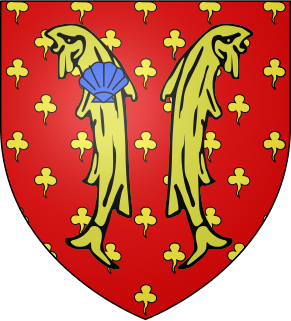
Guy II de Nesle, Lord of Mello, was a Marshal of France (1348) who was killed in the Battle of Mauron.
The Treaty of London (1358) known as the first Treaty of London, was signed during the Hundred Years' War, between the English and French.

1356 is the fourth novel in The Grail Quest series by Bernard Cornwell, first published in 2012. It is set in 1356, nearly a decade after the original trilogy, and culminates with the Battle of Poitiers. Intertwined in the plot is the quest to find La Malice, a fabled sword of Saint Peter and Christian relic which may turn the tide of the long war for France. It is Cornwell's fiftieth novel.
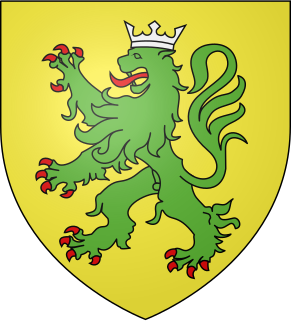
Robert VIII Bertrand de Bricquebec, also known as Robert Bertrand, Baron of Bricquebec, Viscount of Roncheville, was a 14th century Norman noble. He served as Marshal of France from 1325 until 1344.
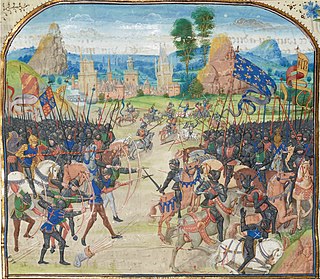
The Black Prince's chevauchée of 1356 was a large-scale mounted raid by an Anglo-Gascon force under the command of Edward, the Black Prince, between 4 August and 2 October 1356 as a part of the Hundred Years' War. The war had broken out in 1337, but a truce and the ravages of the Black Death had restricted the extent of the fighting since 1347. In 1355 the French king, John II, determined to resume full-scale war. That autumn, while Edward III of England threatened northern France, his son, Edward of Woodstock, later known as the Black Prince, carried out a devastating mounted raid, or chevauchée: an Anglo-Gascon army marched from the English possession of Gascony 675 miles (1,086 km) to Narbonne and back. The French refused battle, despite suffering enormous economic damage.
The Treaty of Guînes was a draft settlement to end what has since been called the Hundred Years' War, negotiated between England and France and signed at Guînes on 6 April 1354. The war had broken out in 1337 and was further aggravated in 1340 when the English king, Edward III, claimed the French throne. The war had gone badly for France; the French army was crushed at the Battle of Crécy, and the French town of Calais was besieged and captured. With both sides exhausted, a truce was agreed that, despite being only fitfully observed, was repeatedly renewed.














